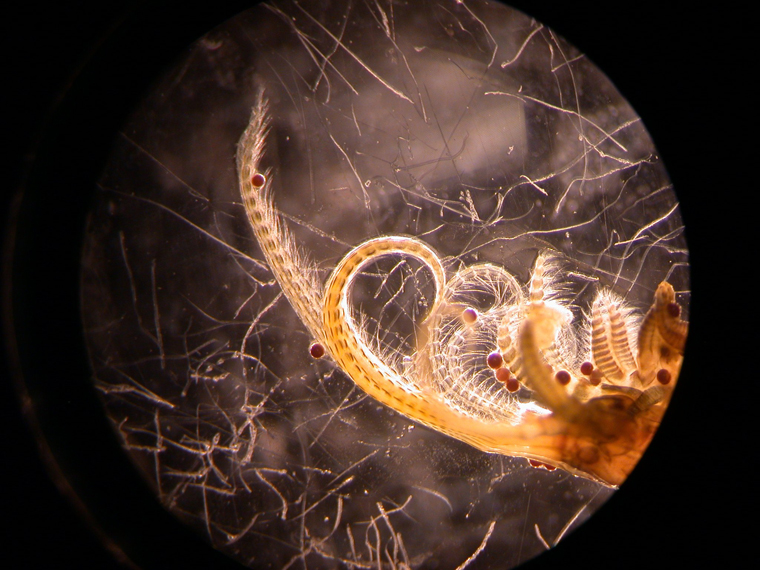Barnacles Coping with an Uncertain World in the San Juan Islands
by Mike Nishizaki
Dr. Mike Nishizaki completed his Ph.D. from the Biology Department at the University of Washington in August of 2013. His advisor for his studies was Professor Emily Carrington. Mike is currently doing Postdoctoral studies at the University of Guelph. We miss him at FHL, but we wish him well!

Michael Nishizaki examining barnacles on Sucia Island, WA.
Inset: barnacles, Balanus glandula. Photo credit: Phil Green
Given the scale and pace of anthropogenic change in marine environments, it is important to understand the manner in which organisms respond to environmental uncertainty. For many aquatic species, fundamental processes such as respiration and feeding are potentially limited by the exchange of materials to and from the sea water. As a consequence, environmental factors such as water temperature and flow can profoundly impact the ecology and physiology of many marine organisms.
My PhD research in Dr. Emily Carrington’s lab at the Friday Harbor Laboratories (FHL) evaluated the role of water temperature and velocity on respiration, feeding and, ultimately, growth in the acorn barnacle Balanus glandula. Barnacles are suspension feeders found on rocky shores around the world. Due to their abundance, these benthic invertebrates dominate large portions of the intertidal zone and are important prey for other invertebrates, fish, and birds. As suspension feeders, barnacles represent an important link between benthic and planktonic communities through their procurement of food particles from surrounding waters.
Temperature, Flow & Physiology. I started my PhD research by measuring the physiological tolerance of barnacles over a wide range of thermal and fluid conditions. In a series of lab experiments, I found that respiration rates increased in response to changes in both temperature and flow. Model analysis helped predict conditions where respiration is limited by the delivery of oxygen versus by the capacity of barnacles to absorb oxygen. When oxygen delivery was most limited (during low-flow high-temperature conditions), barnacles displayed a distinct “pumping” of their cirral appendages, or “legs,” which is a strategy that may serve to increase ventilation and increase the amount of oxygen that they get.

A microscope view of the cirral appendages, or “legs," of Balanus gladula with brine shrimp cysts stuck to them.
Photo credit: Mike Nishizaki
The Hunger Games: Catch and Acquire. Suspension feeding, which entails the capture of food particles from the water column, is a common energy acquisition strategy for sessile (fixed/immobile) marine organisms. I conducted barnacle feeding experiments over a range of water velocities and temperatures using brine shrimp cysts as food particles. One advantage of using cysts was that I could directly count the number ingested by examining the stomach content of individual barnacles. Thus, I was able to quantify the number of particles encountered by each barnacle, the number of particles captured, and the efficiency of capture. This direct method was deemed more accurate than previous approaches that used simple cirral beating activity as a proxy for feeding rate, since no significant correlation between the two was detected in my experiments. However, more detailed measures of behavior (e.g., fully extended versus abbreviated cirral beating) remain important and their inclusion was required before physical models could accurately predict patterns of particle capture.
Putting it together: how physiology & behavior shape barnacle growth. Using the respiration and feeding measurements, I generated predictions about barnacle growth under different environmental conditions. For many benthic marine organisms, body size has direct implications for an organism’s abundance and distribution. One way to predict body size under different environmental conditions is by using energy budget models. Their value lies, in part, in the models' ability to generate predictions about how a species will respond to new environmental conditions that may not exist today.
My first model-testing experiment was conducted at FHL where barnacles were grown in flow-through chambers with different temperatures and water velocities. The growth results were consistent with model predictions, but my question remained: how well would these predictions hold for barnacles under less-controlled field conditions?

Top: aerial view of Argyle Creek and Lagoon on San Juan Island, WA.
Bottom: field site at Argyle Creek Marine Research Preserve.
Photo credit: Mike Nishizaki
To address this question, my second model experiment was conducted at Argyle Creek which joins a saltwater lagoon with the ocean. The lagoon is subject to tidal fluctuation, and consequently, flow in the creek reverses as the tide changes. Significant variation in both water temperature and velocity exist along the length of the creek providing a rare opportunity for experimental testing of my model predictions under different environmental conditions. I measured growth rates for juvenile barnacles that I outplanted at different regions within the creek. These experiments again confirmed model predictions, and suggest that barnacles in Argyle Creek are living under conditions that nearly maximize growth rate. Reduced growth is predicted at extremely low or high temperatures and velocities, each due to a different physiological or behavioral response in respiration or feeding. Moreover, these results underscore the importance of considering the interaction between multiple environmental factors and provide evidence that together, they shape responses in physiology, behavior, and growth.
After leaving FHL, I spent a year at Bowdoin College in Maine as a visiting professor. I am currently a post-doc working in the Great Lakes region where I examine the flux of nutrients and gases between sediments and the overlying water column via eddy-correlation technique. I also serve as editorial assistant for the journal Limnology & Oceanography: Fluids & Environments.
You can find a list of my publications at http://www.mikenish.com/research
Look for Tide Bites in your inbox at the start of each month! To view previous Tide Bites, visit the FHL archive page located on the FHL website.




